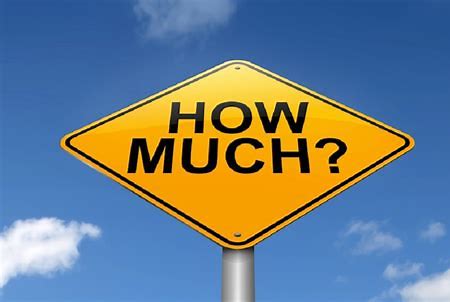How Much Should I Pay For That?
How much should I pay for that?

In last week’s post I discussed the BLS (bureau of labor statistics) April 2018 consumer expenditure report. This week’s post is going to expand on that and focus on the BLS generational report (i.e., BLS birth year.xls).
https://www.bls.gov/cex/csxresearchtables.htm#crosstab
I think this report is a great way to see how much others spend on certain expenses(for example their cell phone bill). I especially like the generational report because you can narrow your comparison to others in your same age cohort; which makes the comparison more relevant. My argument is that a millennial’s expenses will be quite different from that of baby boomer who recently retired. Therefore, use the BLS generational table and pick your respective generation’s column and find out what your cohorts spend on life’s normal, every day expenses. Last week we focused on the percentage of your income you spend on these categories but this week we’re going to compare the actual expenses in good old US dollars. The numbers below are for a household income of about $94,000. This might be more or less than your situation but sometimes percentages get a little vague and abstract. I need some real numbers!

One word of caution however, the BLS survey is what the “average” person in your generation spends on something (e.g., car payment). This proverbial “average” person isn’t really meant to be held up as some kind of ideal. Quite the contrary, this “average” person is really the C student in school. It’s a useful reference to see how a C student did on the test, but I wouldn’t celebrate too much if you are at, or slightly better, than a C student (don’t celebrate mediocrity!). Conversely, don’t console yourself if you’re only slightly worse than this proverbial C student. Please see my previous post on why its actually a really good thing to be super average (um. . . yeah. . . not so much. . .).
https://jimmysmoneytips.com/2017-12-04/q-whats-so-wrong-with-being-average-wait-for-it/
I’m a Gen Xer so I’ll be using that generation as my reference point, see their numbers below; however, you should choose your respective generation and consider why are you doing better or worse than “average”. If you are worse than the average then you should absolutely sit around the kitchen table and ponder how can I improve? Enough small talk, let’s get to the numbers!
| Gen X | ||
| $809 | Food (includes alcohol) | |
| 420 | groceries | |
| 341 | restaurants | |
| $1,104 | modified food & groceries to include pets, personal care (e.g., shampoo) and household goods (e.g. laundry and cleaning supplies) | |
|
$1,858 |
housing | |
| 1,483 | total mortgage including property taxes and insurance | |
| 33 | natural gas | |
| 134 | electricity | |
| 139 | phone | |
| 53 | water | |
| 16 | other | |
| $913 | transportation | |
| 402 | car payment | |
| 201 | gasoline | |
| 102 | insurance | |
| 78 | repairs/maintenance | |
| 129 | other – including public transport | |
| $370 | healthcare including premiums, Rxs and doctor visits | |
| $365 | entertainment | |
| 122 | pets | |
| 102 | tv | |
| 82 | admissions | |
| 60 | other | |
| $743 | insurance/social security | |
| $731 | miscellaneous | |
| 168 | charity | |
| 224 | clothing | |
| 340 | other (reading, education, personal care, tobacco, etc.) | |
| $2,034 | taxes/savings | |
| $7,823 | total expenditures | |
| $7,823 | monthly gross income | |
| $93,876 | annual gross income | |
I will include some of my own numbers (in blue, below) to take some of my own medicine. . .
Food and groceries. We spent $1,187 per month on food and groceries in Q1. That’s higher than the reference of $1,104, which is the modified food/groceries number from the BLS. It’s modified to include pet food/supplies, personal care items (e.g., shaving cream), and household goods (e.g., laundry detergent). I used the modified approach because we buy most of our groceries at Wal-mart and this includes things like cat food, shampoo, and air filters; we don’t account for these items separately. These last items get categorized by the BLS as entertainment (pet expenses), miscellaneous (personal care), and housing (air filters). I believe it’s pretty easy to diagnose my problem here – it’s going out to eat! I know I should bring my lunch to work most days and should avoid restaurants – especially desserts. . .

Housing. I think it’s better to break this down into its components

Our monthly mortgage payment is $1,207 which includes property taxes and insurance. I believe the comparable BLS number is $1,483 but that might be a touch high due to their inclusion of household maintenance, which my mortgage payment doesn’t . . .
Our combined monthly electric and natural gas bill is $167 per month ($95 for electric and $72 for natural gas) on the equal payment plan (EPP). This is actually the exact same as the BLS average of $167. How ironic. See my previous post on how to lower your heating & cooling bills.
https://jimmysmoneytips.com/2017/07/15/top-ways-to-reduce-your-heating-and-cooling-cost/
Our cell phone bill is $132 per month, slightly better than the BLS average of $139 per month. See my previous post on how to save money on your next smartphone purchase.
https://jimmysmoneytips.com/2017/07/21/think-like-a-boss-save-858-on-your-iphone/
Our water bill averages $62 per month (Q1), slightly higher than the BLS average of $53.
Transportation. Let’s try rapid fire. Our car payment is $402 per month (same as the BLS). We spent $338 per month (Q1 average) on gasoline (BLS average is $201). We spend $168 per month on car insurance (BLS average is $102). Not my best category. . .

I spent more on healthcare and charity but about the same on TV. I think you get the idea. Plug in your numbers and see if you’re doing better or worse than the BLS averages?
I know this exercise (and this post for that matter) were a little detailed (a.k.a, boring!) but sometimes personal finance involves a little number crunching and some critical thinking about how you can spend less . . .



